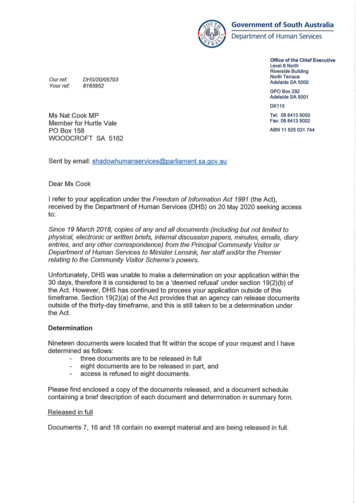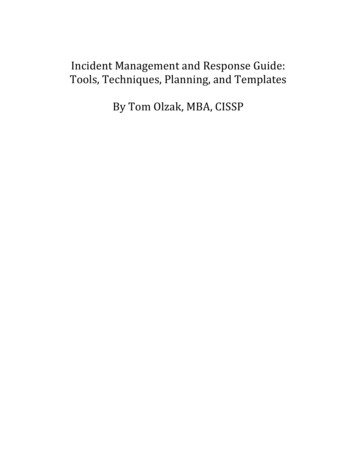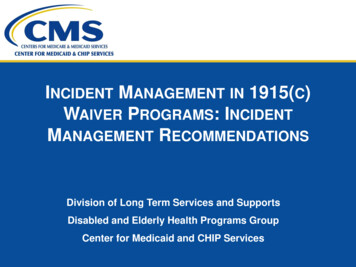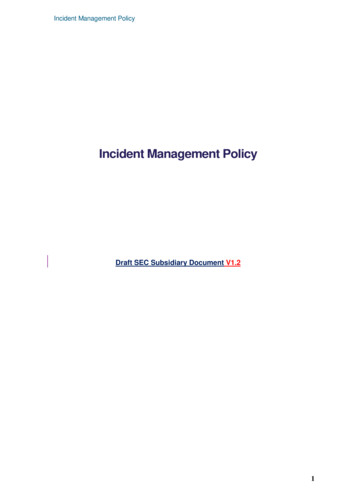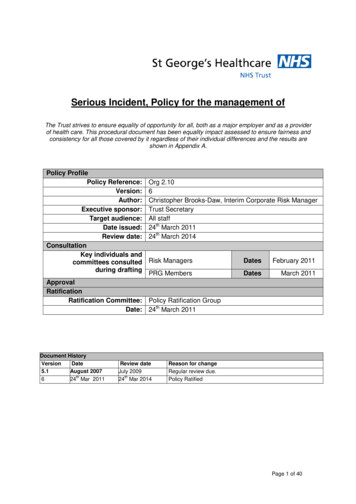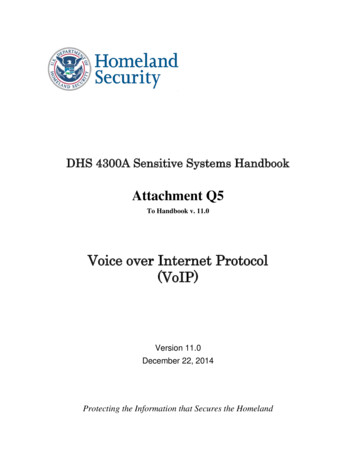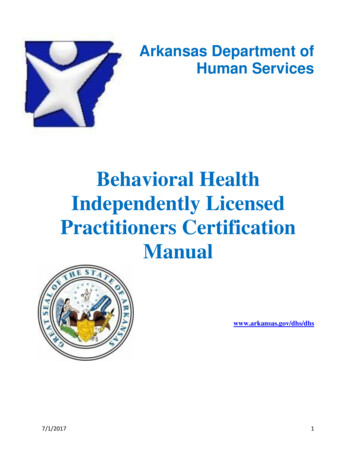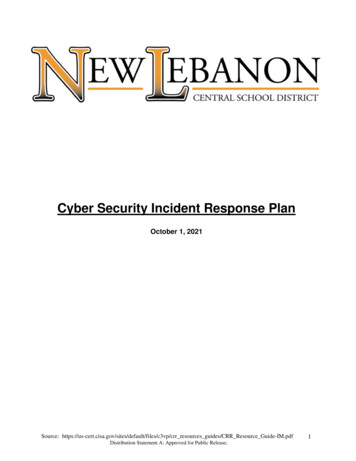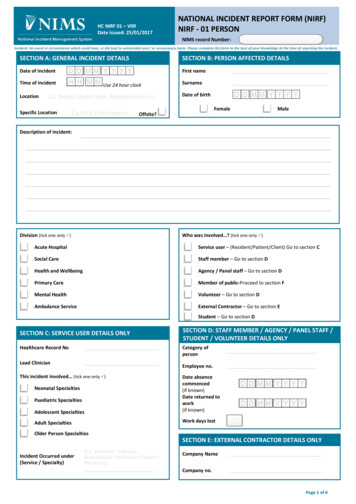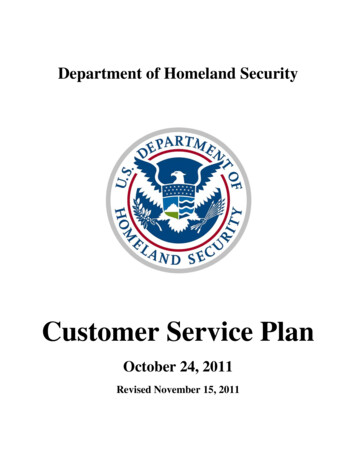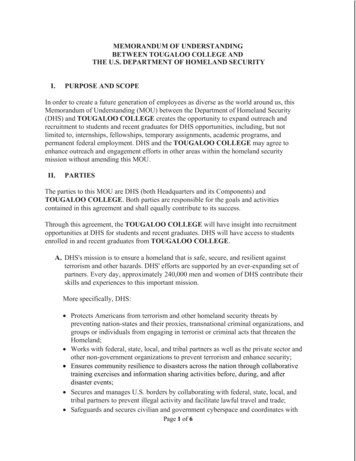
Transcription
INCIDENT MANAGEMENTINFORMATION SHARINGDHS S&T First Responders Group
ContentsExecutive Summary. 2PART I – THE CASE FOR THE INCIDENT MANAGEMENT INFORMATION SHARING CAPABILITY MATURITY MODEL . 31.1Capability Maturity Model Introduction . 31.2Purpose of the Incident Management Information Sharing CMM . 31.3Intended Benefits and Uses of an IMIS CMM . 41.3.1Benefit of the IMIS CMM . 41.3.2Uses of the IMIS CMM . 4PART II – IMIS CMM FRAMEWORK V1.1 . 62.1Purpose . 62.2Defining the IMIS CMM. 72.3IMIS CMM Core Elements . 82.4IMIS Maturity Levels . 102.5IMIS CMM Attributes . 11PART III – IMIS CMM IMPLEMENTATION . 193.1Overview of IMIS CMM Implementation Assessment Framework. 193.2Target Information Sharing Capabilities . 203.3IMIS CMM Self-Assessment . 20Appendix A: Acronyms . 21Appendix B: Incident Management Information Sharing Capability Maturity Model Self-AssessmentImplementation Guide . 221 Page
Executive SummaryIn many situations, federal, state, local, tribal and territorial government agencies; non-governmentalorganizations; and private sector partners in the incident management community do not have cleardirection on the most optimal ways to discover or share mission-critical information and to objectivelyassess their capabilities. Although there are general guidance materials available, none provide detailsspecific to an entity’s maturity level as it relates to Incident Management Information Sharing (IMIS).The IMIS Capability Maturity Model (CMM) is being developed by the Department of Homeland Security(DHS) Science and Technology Directorate’s (S&T) First Responders Group (FRG) in partnership with theDHS Office of Emergency Communication’s SAFECOM program and local first responder communities.An after action report (AAR) following the Central U.S. Earthquake Consortium Capstone-14 Exerciseclearly identified the requirement for an IMIS CMM. The report stated that “a Capabilities MaturityModel would help agencies measure their maturity along a continuum and help to guide their pathforward” and further said that a CMM “could result in significant opportunities to eliminate redundantdata entry processes, reduce data entry errors and collect more detailed information.” FRG leads theIMIS CMM effort to identify and understand gaps in information sharing. By leading this effort, FRG alsoaims to increase IMIS capabilities and prepare for future data-related initiatives.The basis of the IMIS CMM are the core elements, derived from the five inter-dependent elements ofthe SAFECOM Interoperability Continuum 1 (Governance, Technology, Standard Operating Procedures,Training and Exercises, and Usage). Additional details are collected through the IMIS CMM attributes,specific to each of the core elements. These core elements and attributes are used extensively tomeasure the maturity of an organization’s incident management and information sharing capabilities.Overall, the development and deployment of the IMIS CMM will help entities measure their specificmaturity related to IMIS. The assessment will provide opportunities for the entity to compare itscurrent-state against proposed future-state objectives. The derived information can also serve a role inthe identification of specific deficiencies and support requests for required blications/interoperability continuum brochure 2.pdf2 Page
PART I – THE CASE FOR THE INCIDENT MANAGEMENT INFORMATION SHARINGCAPABILITY MATURITY MODEL1.1Capability Maturity Model IntroductionA Capability Maturity Model (CMM) is a framework that describes the key elements of an effectivepractice. It describes an evolutionary improvement path from an ad hoc, immature process to a matureand disciplined process. A CMM establishes a means for strategic measurement by which it is possible tojudge, in a repeatable way, the maturity of an organization's processes, compare it to the state of thepractice of the industry, and/or serve as the basis for an organization to plan improvements to itsprocesses. Overall, a CMM is comprised of a collection of best practice-based characteristics that assistan organization in identifying competencies and support the improvement of its processes.As explained in The Open Group for Architecture Frameworks (TOGAF) Architecture Maturity Models, inrecent years the industry has witnessed significant growth in the area of maturity models. Themultiplicity of models available has led to problems of its own, in terms of how to integrate all of thedifferent models to produce a meaningful metric for overall process maturity.In response to this requirement, the Software Engineering Institute (SEI) developed a framework calledthe Capability Maturity Model Integration (CMMI). According to the SEI, the use of the CMMI modelimproves on the best practices of previous models in many important ways. In particular, it enablesorganizations to: 1.2More explicitly link management and engineering activities to business objectives;Expand the scope and visibility of the product lifecycle and engineering activities to ensure thatthe product or service meets customer expectations;Incorporate lessons learned from other best practice areas (e.g., measurement, riskmanagement and supplier management);Implement more robust high-maturity practices;Address additional organizational functions critical to its products and services; andComply more fully with relevant International Organization for Standards.Purpose of the Incident Management Information Sharing CMMThe Incident Management Information Sharing (IMIS) CMM will enable the maturation of incidentmanagement-related information sharing processes and capabilities. It is intended to improve andbroaden the sharing of specific information that originates within episodes of incident response andsupport. In addition, it addresses IMIS abilities at all levels of government, as well as non-governmentalorganizations (NGOs) and private sector partners.The IMIS CMM will enable the creation and progressive enhancement of an information sharingenvironment (ISE) that enables users to locate the people, services and data/information necessary toperform the job of emergency and incident management. A mature IMIS environment will define: What information is available;What services are available;What authorizations are required;3 Page
1.3The rules under which information is made discoverable and can be shared; andHow to access to or deliver requested information on a sustainable basis.Intended Benefits and Uses of an IMIS CMM1.3.1 Benefit of the IMIS CMMThe IMIS CMM will assist the mission of incident management to continue to improve technical,operational and strategic enhancements to the maturity level of processes within jurisdictions at alllevels of government. A diagram of the various capabilities addressed across the IMIS CMM is depictedin Figure 1 below. Over time, the IMIS CMM is intended to: Lead to better informed first responders through improved interoperability and informationagility;Provide a logical pathway to technical and functional advancements in IMIS;Assist organizations in creating a consistent, nation-wide IMIS governance approach whilederiving value from their IMIS investments;Support resourcing requests and return on investment analysis; andImprove information security and integrity while increasing the technical abilities of incidentresponse.Figure 1: IMIS CMM Diagram1.3.2 Uses of the IMIS CMMJust as the use of disciplined processes have been shown to enable more predictable implementation ofprojects and programs, they also produce higher quality services and information systems. Overallbusiness performance of organizations involved in incident management can be improved by applyingthe concepts defined in the IMIS CMM.4 Page
For internal use, the IMIS CMM provides a clear ranking of an entity’s current state. By exploring therequirements to advance to the next maturity level, funding, staffing, changes in policies and technologycan be easily identified for improvement. With the opportunity for an entity to compare itself withanother of similar demographics, the dialog between them is instantly open to compare and supportone another in advancing areas of interest. Additionally, the results of the assessment may assist insupporting documented requests, internally and/or externally, for additional resource requirements.The implementation of the IMIS CMM will empower entities to provide strategic guidance andleadership in the area of incident management. Through the deployment of the Self-Assessment Tool,the IMIS will advance the national dialogue around which tools and methods can and should bedeployed to improve situational awareness and information sharing capabilities at all levels ofgovernment.5 Page
PART II – IMIS CMM FRAMEWORK V1.12.1PurposeThe IMIS CMM is intended to help state, local, tribal, and territorial (SLTT) agencies; federal entities;non-governmental organizations; and private sector partners in the incident management communityaccess and share mission-critical data and information. Although general guidance materials arecurrently available, none provide details specific to an entity’s maturity level as it relates to IMIS. Atbest, the as-is environment is often disconnected, as depicted in Figure 2, below.Figure 2: As-Is ISE GraphicThe IMIS CMM identifies the directives and authorities supporting the effort to include examples ofCMM models referenced in the IMIS CMM design and details on its future development. The proposedIMIS environment depicted in Figure 3, below, will: Create a basis for comparing capabilities among diverse groups on a local, state, regional andnational level;Provide a standard way of measuring progress across diverse organizations;Establish objective and performance-based criteria for the Department of Homeland Security(DHS) Federal Emergency Management Agency (FEMA) and Science and Technology Directorate(S&T) funding and resource decisions;6 Page
Create a focus for governance and coordination efforts;Provide a basis for assessing, monitoring and reporting outcomes;Support objective program management; andEstablish methodology and a framework for ongoing assessment of evolving maturity of theIMIS environment.Figure 3: Proposed To-Be ISE Graphic2.2Defining the IMIS CMMThe IMIS CMM characterizes stages of maturity as they relate to an organization’s incident managementmaturity levels and information sharing capabilities. The intent of the IMIS CMM is to evaluate anorganization’s capability against both of these maturity frameworks according to specific attributedescriptions provided from the Interoperability Continuum. The assessment process is organized aroundthe five SAFECOM attributes and the related core elements.The IMIS CMM is broken-down into three distinct layers of detail (as depicted in Figure 4, below): Core Elements – Adopted from SAFECOM, the core elements divide the overall IMIS mission intofive manageable topics.Maturity Levels – The IMIS CMM Maturity Levels provide a simplistic tool for measuring maturitythrough the details presented within the attributes.Attributes – These are the finite detail of the IMIS CMM, breaking-down the core elementswithin the five maturity levels to convey a means to measure current status and progress withinthe IMIS CMM.7 Page
Figure 4: IMIS CMM Detail GraphicThe IMIS CMM assessment results address both information management and information sharingstages to provide an accurate perspective on an entity’s rating. Information management is critical toboth effective availability and overall mission relevance. With regard to information sharing, the overallobjective of the IMIS CMM is to empower entities with the ability to share information freely in a secureand collaborative environment. The IMIS CMM core elements, maturity levels, and attributes arediscussed in detail below.2.3IMIS CMM Core ElementsThe IMIS CMM core elements are derived from the five inter-dependent elements of the SAFECOMInteroperability Continuum 2 (Governance, Technology, Standard Operating Procedures, Training andExercises, and Usage). These elements are used extensively to measure the maturity of an organization’sincident management and information sharing es/publications/interoperability continuum brochure 2.pdf8 Page
Figure 5: SAFECOM Continuum Graphica. Governance - Establishing a common governing structure for solving issues related to incidentmanagement, information management and information sharing will improve the policies,processes and procedures of organization by: enhancing communication, coordination andcooperation; establishing guidelines and principles; clearly defining decision rights and roles andresponsibilities; and reducing any internal jurisdictional conflicts. Governance structures providethe framework in which stakeholders can collaborate and make decisions that represent acommon objective. It has become increasingly clear to the incident management andemergency response community that IMIS and communications interoperability cannot besolved by any one entity; achieving effective and efficient IMIS and communicationsinteroperability capabilities requires a partnership among emergency response organizationsacross all levels of government. As such, a governing body should consist of SLTT and federalentities, as well as representatives from all pertinent emergency management and first responsedisciplines within an identified region.b. Technology - Technology is a critical tool for improving IMIS and communicationsinteroperability capabilities, but it is not the sole driver of an optimal solution. Successfulimplementation of technology/tools must be supported by strong governance and is highlydependent on effective collaboration and training among participating organizations andjurisdictions. Technologies should meet the interoperability requirements of practitioners on thefront lines while addressing regional needs, existing infrastructure, cost vs. benefit andsustainability. The technologies organizations deploy must be scalable to effectively supportday-to-day incidents as well as large-scale disasters. Often, a combination of technologies will benecessary. Security and authentication challenges are present in each technology and must beconsidered in all implementation decisions.c. Standard Operating Procedures - Standard Operating Procedures (SOPs) are formal writtenguidelines or instructions for incident management, information management and information9 Page
sharing within and across jurisdictions; they typically have both operational and technicalcomponents. Established SOPs enable emergency management professionals and firstresponders to successfully coordinate an incident management/response across disciplines andjurisdictions. Clear and effective SOPs are essential for developing and deploying any IMISand/or interoperable communications solution.d. Training and Exercises - Implementing effective training and exercise programs to practice IMISand communications interoperability is essential for ensuring that the technology works andresponders are able to effectively share information and communicate via multiple methods(e.g., voice and data) during emergencies.e. Usage - Usage refers to how often IMIS and interoperable communications technologies areused. Success in this element is contingent upon progress and interplay among the other fourelements on the Interoperability Continuum.2.4IMIS Maturity Levels 3The IMIS maturity levels provide a maturity categorization across the IMIS core elements with theintention of rating an entity across a 0-5 scale within each element. The levels are defined below. Level 0: No CapabilityLevel 1: AwarenessThe entity is somewhat aware of the data/information available from SLTT and federal partnersand is not certain where or how to obtain access on a consistent or sustainable basis. Theyoperate without established IMIS objectives and their processes and practices are inconsistentand unpredictable with a high risk of variation and deficiency. Deficiencies are not systematicallyidentified and employees’ roles and responsibilities and not defined or documented.Level 2: Planning and DevelopmentThe entity is actively coordinating with a governing body to build operational capacity for IMIS.Formal planning activities and objectives are in place, but are not yet prioritized orimplemented. Incident management processes and practices are dependent on the knowledgeof individuals and their personal relationships with others. Initial discussions with informationsharing partners regarding the establishment of formal information sharing agreements andprotocols are underway, but are not yet documented. The entity is generally aware of thedata/information available from SLTT and federal partners but has not developed formalrelationships for access. Effectiveness is not adequately evaluated, and defined roles andresponsibilities for information management may not be fully documented or understood by allemployees.Level 3: Limited Operational CapabilityObjectives are in place, prioritized and adequately documented. Incident managementprocesses and practices are evaluated on a periodic basis. The evaluation process is not welldocumented, however. The entity is aware of the data/information available from SLTT andfederal partners; it has agreements in place and has documented and uses some formalinformation sharing agreements/protocols. The entity has defined the Essential Elements ofInformation (EEIs) required to support operations and is capable of using both static anddynamic EEIs to support daily internal operations. Employees are aware of their documented3Note: The stage definitions were inspired by the emergency management maturity level definitions discussed onpage 12 of the 2008 Tiems Emergency Management Maturity Model prepared by Booz Allen Hamilton.10 P a g e
2.5IMIS roles and responsibilities and are capable of discovering, creating, consuming, publishing,sharing and securing data/information from various internal and external sources into aconsolidated daily situational awareness view.Level 4: Extended Operational CapabilityThe entity has an institutionally adopted enterprise-level capability to manage informationinternally and to share both static and dynamic information with external partners at variouslevels for operational use. Employees are aware of their documented roles and responsibilities,and technology is applied tactically to ensure the use of predictable and consistent IMISprocesses and practices. IMIS objectives are in place, documented, prioritized and reviewed on aperiodic basis. Incident management processes and practices are evaluated on a scheduled basisand consistent follow-up addresses identified process deficiencies. Formal information sharingagreements and protocols for all EEIs and other critical data/information are documented andused on a consistent basis.Level 5: Mature Operating CapabilityThe entity is capable of adapting to unfolding incidents/events and providing the appropriatedata discovery, sharing, analysis, and recommendation for decision making. Technology isstrategically applied to ensure continuous assessment, monitoring and improvement of the IMISprocesses and practices to optimize their enterprise-level capabilities. Employees are aware oftheir documented roles and responsibilities and are proactively involved in continuous processimprovement. Objectives are in place, prioritized, reviewed on a scheduled/continual basis anddocumented. The evaluation process is well documented and consistent follow-up addressesidentified process deficiencies.IMIS CMM AttributesThe IMIS CMM Attributes in Tables 1-5, further define the core elements so as to refine anorganization’s understanding of the maturity level of its incident management operations, informationmanagement and information sharing capabilities. These attributes are utilized by the IMIS CMM toprovide the means for an entity to complete the IMIS CMM self-assessment.Table 1 – IMIS CMM Governance AttributesIMIS CMM Governance ElementLevel 0: No CapabilityLevel 1: AwarenessGV101 - The entity acknowledges the value of IMIS and the intention to establish working groups to implementthe operational IMIS capabilities.GV102 - Personal connections enable some information sharing and collaboration to occur.GV103 - Technical staff implement ad hoc governance activities on behalf of the entity.GV104 - The entity recognizes that IMIS activities will require dedicated staff and funding.GV105 - The entity has internal executive-level support for the development of an IMIS program.Level 2: Planning and DevelopmentGV201 - An IMIS Executive Committee has been established. Members represent functions that include broadexecutive leadership (e.g., Emergency Management Director, Homeland Security Advisor, GeospatialInformation Officer (GIO), Chief Information Officer (CIO) and Chief Financial Advisor).GV202 - An IMIS Governance Working Group (EQV) has been established.GV203 - IMIS working groups have been established to address SOPs, Technology, Training and Exercises, andUsage with defined cross-collaboration and meeting schedules.GV204 - The entity has an IMIS strategy that aligns with various local and national strategies/policies.11 P a g e
IMIS CMM Governance ElementGV205 - The entity has an IMIS Action Plan in place to monitor its progress in attaining its desired to-be state.GV206 - Written and approved entity policies exist for IMIS enterprise development, maintenance and use.GV207 - IMIS Executive Committee takes proactive steps to identify, prioritize and address IMIS cultural barrierswhile socializing concepts across the community.GV208 – The entity has developed a Work Breakdown Structure and schedule to implement the IMIS enterprise.GV209 - The entity has initiated engagements with internal stakeholders to draft policies and procedures forIMIS coordination.GV210 - The IMIS Executive Committee has a business plan to support budget and funding requirements relatedto geospatial programs and IMIS for the emergency management and first responder communities.GV211 - An IMIS Enterprise Implementation Plan is in development to address relationships with othermanagement disciplines.Level 3: Limited Operational CapabilityGV301 - The Governance Executive Committee is formally chartered.GV302 - IMIS related risks are proactively identified, reported and mitigated.GV303 - The entity has conducted a Privacy Impact Assessment.GV304 - An IMIS Business Plan has been developed to support first responders, including budgeting andtraining/exercises.GV305 - The Governance Executive Committee has reviewed/commented on budget/funding issues related togeospatial programs and information sharing for first responders.GV306 - The entity has a system to address integration of new requirements and ensure minimal repetition ofpreventable issues.GV307 - IMIS budgetary requirements are validated for funding.GV308 - IMIS human capital plans exist and are met (where applicable).GV309 - The IMIS Executive Committee is fully represented and is responsible and accountable for all aspects ofthe IMIS capability development.GV310 - The IMIS Executive Committee has approved the draft IMIS Action Plan and directed it to the workinggroups for final approval specific to their respective workflow requirements.GV311 - The entity has defined policies, procedures and protocols to enable IMIS coordination with internalstakeholders and external partners.Level 4: Extended Operational CapabilityGV401 - The entity has an information sharing strategy that is aligned with various local, regional, tribal andnational strategies and policies.GV402 - The entity coordinates the development of information sharing grant requests and oversees executionof scope for awards grants.GV403 - The entity coordinates with regional SLTT partners, federal agencies, critical infrastructure/key resource(CIKR) partners and NGOs to develop and implement IMIS information sharing agreements.GV404 - The entity has a published SOP inclusive of all EEI sharing aspects and the intended use/context of usefor various functions.GV405 - IMIS Human Capital capabilities are continuously improved.GV406 - An IMIS Enterprise Program Office (EQV) has been established.GV407 - The entity has legal frameworks (i.e., policies, procedures and protocols) in place that guide/enableIMIS with internal stakeholders and external partners.GV408 - Technology recommendations are collected for information sharing standards and provided to the CIOfor establishment and enforcement.GV409 - The entity has established a privacy policy to include For Official Use Only, Law Enforcement Sensitive,Sensitive But Unclassified, Protected Critical Infrastructure Information, etc.Level 5: Mature Operating CapabilityGV501 - The entity is fully engaged at SLTT and national levels, governing standards for technology, budgets,grant requests, interoperability, business planning, training and usage.12 P a g e
IMIS CMM Governance ElementGV502 - The entity has an outreach program to build partnerships with SLTT, federal government, NGO andprivate sector partners, and to inform representatives, senior executives, political leaders and strategic partnerson the IMIS capabilities available to them.GV503 - A methodology is executed to ensure that governance activities are continuously monitored forimprovements (continuous feedback loop).GV504 - The entity's business plan is updated on annual basis to reflect lessons learned from training, exercisesand incident response, and proposes budget incentives.GV505 - IMIS inputs impact the entity's budget formulation and execution for first responder informationsharing.GV506 - The entity has appropriate business continuity plans (to include Continuity of Operations Planning(COOP) and Continuity of Government (COG)) developed that clearly identify how IMIS would be conducted in adegraded environment.Table 2 – IMIS CMM SOP AttributesIMIS CMM SOP ElementLevel 0: No CapabilityLevel 1: AwarenessSO101 - Information requirements are generally understood among technical staff but are not systematicallydefined or documented.SO102 - Information sharing processes are not currently repeatable and are dependent on the knowledge of afew individuals.SO103 - Individual notes and processes have been collected in an effort to leverage existing contacts and shareddata to support future documentation to be accessible to all staff.SO104 - The entity has not formalized information sharing templates, job aids, SOPs or ad-hoc processdocuments.Level 2: Planning and DevelopmentSO201 - An IMIS SOP Working Group (EQV) has been established.SO202 - SOPs for data sharing are in development between agencies for local hazards and threats.SO203 - A targeted interoperability framework and architecture for IMIS exists, has been approved by theoperations working group and executive committee, and is promoted by the CIO (or EQV).SO204 - IMIS SOPs have been developed to address general data management, maintenance and currency.SO205- SOPs for the collection of incident data fully address metadata requirements identified by the UsageWorking Group.SO206 - Data sharing agreements and use agreements have been initiated with internal and external partners.SO207 - An IMIS SOP had been developed to reference policies for identification and documentation ofauthoritative information.SO208 - Relevant SOPs include details on technical skills required by key staff.Level 3: Limited Operational CapabilitySO301 - Joint information sharing SOPs have been developed between some key agencies and have beenreviewed and approved by the SOP working group.SO302 - Standards have been documented for internal enterprise-level information sharing.SO303 - A comprehensive plan is in place to ensure approval of IMIS SOPs by the Governance and other workinggroups.SO304 - IMIS SOPs and products are being developed/deployed according to a documented met
The Incident Management Information Sharing ( IMIS) CMM will enable the maturation of incident management-related information sharing processes and capabilities. It is intended to improve and broaden the sharing of specific information that originates within episodes of incident response and support.
